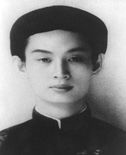PHẬT GIÁO HÒA HẢO
HARMONY BUDDHISM
Lower Age -- Hạ Ngươn Mạt Ph́áp -- 下元 末法
Viet: Đời Hạ Ngươn. Hạ is Lower, and Ngươn or Nguyên, Đời, means Age, Era, Period. This is an Buddhist lexicon which means the Degenerate Era during which Buddha's dharma loses all its power and, though many have learnt it, very few of them understand and practice it.
According to the Potato Peddling Monk (Sư Vải Bán Khoai), the Year of the Wood Rat (Giáp Tý) or the coming year of 1864 starts the Dharma Closing Lower Age : The Lower Age starts with the Year of the Wood Rat, No place over the world will be left in peace. Or the Wood Rat of the Lower Age starts nowadays, the Heavenly Engine will set up the Upper Age. Or
The Wood Rat brings a lot of misery,
No peace reigns on the world daily.
(Sermons by the Potato Peddling Monk of the Seven Mountains, p. 6)
Sư Vải Bán Khoai is deemed one of the precursors to the Master Huynh Phu So, the founder of Hoa Hao Buddhism.
Research on Sư Vải Bán Khoai (in Vietnamese)
In the ‘Awakening Stanzas’ (Giác Mê Tâm Kệ), Lord Master has predicted the aweful frightening disasters which all the sentient beings must go through in the Lower Age:
The sufferings are not so numerous today,
Tomorrow’s ones will be feared full of catastrophe.
Evildoers will be eradicated, the good salvaged,
Bones and blood fill mountains and streams horribly.
In the Mission Statement, Lord Master said: “The Heavenly Reporter concluded, the sentient beings over this world in this Lower Age who are materialistic, and drowned in wealth and fame, have created their bad karma...” Thus there are a lot of Holy Spirits who will have descended to admonish the masses but hide themselves in waiting for their time.
Mad and Crazy endure silently and wait ,
Disguising ourselves to guide the livings of the Lower Age.
Awakening Stanzas p. 637
"At the Lower Age , the world is ending,
The upheaval disrupts all family bases."
The Oracles Vol. P 1 & 2
From another source, the Dharma has four periods, that consists of
1.-Authentic Dharma,
2.-Analytical Dharma,
3.-Simulated Dharma, and
4.-Closing Dharma.
After the Shakyamuni Buddha entered nirvana, the Authentic Dharma period that followed this event lasted 500 years is called the Authentic Dharma, after which the two following periods, Analytical and Simulated, last 500 years, and the last period is the closing Dharma period. As this Age is characterized by the lower moral expectations which most sentient beings have about themselves and others, therefore, it is called Lower Age, or the Age that marks the world going to end, before the cycle restarts with the returning of the Upper Age. Based on the sixth volume of Mahayana (Great Vehicle School), Buddhism which reached the Lower Age period, the Dharma better spreads over the world and, even though many people enter the religion, they do not become Buddhas, therefore it is called the Dharma Closing Age.
The Fifth Patriarch Heng Ren who used his mind to mind communication method to appoint Hui Neng as the Sixth Patriarch, his heir, said: “The Cloak and the Bowl now are passed to you for this age, and it will not be useful to pass them on again. This period is called the Closing Dharma one, though people who listen to the Dharma are many, the real practisers are as rare as hen’s teeth.”
The Great Nirvana Sutra, Vol 7, said: “Buddha told Ga Ye (Vie: Ca Diếp): 700 years after I entered Nirvana, the Po Xún Demon (Vie: Quỷ Ba Tuần; Chi: 魔波旬; Pali: Māra–pāpman) will gradually confound my authentic Dharma. For example, if the hunter wears the Dharma cloak, the Po Xun Demon will do the same, feining Bikkhu or Bikkhuni, or lay male or female Practicers. They also pretend as the Stream-Entrant, and A Luo Han. The Demon borrowed the unwholesome figures to make itself wholesome figures, to corrupt my authentic Dharma."
Source: xuefonet Extract - Closing Dharma Period.
Three Ages of Buddhism
The Three Ages of Buddhism are three divisions of time following Buddha's passing:
1. Former Day of the Law—also known as the Age of the Right Dharma (Chinese: 正法; pinyin: Zhèng Fǎ; Jp: shōbō), the first thousand years (or 500 years) during which the Buddha's disciples are able to uphold the Buddha's teachings;
2. Middle Day of the Law—also known as the Age of Semblance Dharma (Chinese: 像法; pinyin: Xiàng Fǎ; Jp: zōhō), the second thousand years (or 500 years), which only resembles the right Dharma;
'3. Latter Days of the Dharma—also known as the Degenerate Age (Chinese: 末法; pinyin: Mò Fǎ; mòfǎ; Jp: mappō), which is to last for 10,000 years during which the Dharma declines. In the Mahasamnipata Sutra, the three periods are further divided into five five-hundred year periods (五五百歳 Cn: wǔ wǔ bǎi sùi; Jp: go no gohyaku sai), the fifth and last of which was prophesied to be when the Buddhism of Gautama Buddha would lose all power of salvation and a new Buddha would appear to save the people. This time period would be characterized by unrest, strife, famine, and natural disasters.[6] The three periods are significant to Mahayana adherents, particularly those who hold the Lotus Sutra in high regard, namely the Tiantai and Tendai and Nichiren Buddhism, who believe that different Buddhist teachings are valid (i.e., able to lead practitioners to enlightenment) in each period due to the different capacity to accept a teaching (機根 Cn: jīgēn; Jp: Nikon) of the people born in each respective period.

